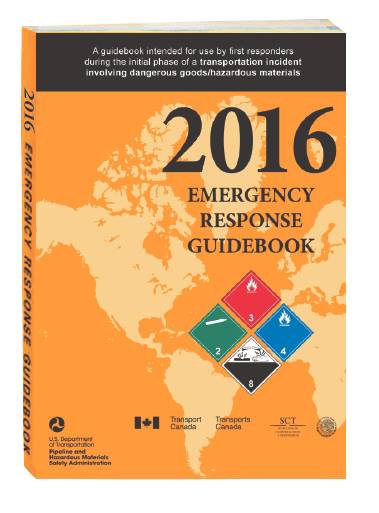Essential Resource for Transportation or Handling Incidents Involving Hazardous Materials
Labelmaster offers the 2016 edition of the Emergency Response Guidebook (ERG) – a must have for anyone who handles or transports dangerous goods (hazardous materials). The ERG is a go-to manual to help responders quickly identify the specific or generic classification of the hazardous material or materials that may be involved in an incident, which helps protect themselves and the general public during the initial response phase.
The ERG is published every four years by the U.S. Department of Transportation’s (DOT) Pipeline and Hazardous Materials Safety Administration (PHMSA) to meet updated regulations and new products and technology, and incorporate relevant feedback from emergency responders. The 2016 ERG is due to be released in the first quarter of 2016.
The new version includes 10 added, revised or expanded sections, covers approximately 3,500 materials and features 62 separate guides for describing what to do when different categories of hazardous materials are released.
Updates to the 2016 ERG edition include:
- Expanded Rail Car Identification and Road Trailer Identification charts
- Added information about Globally Harmonized System of Classification and Labeling of Chemicals (GHS) markings
- Expanded table of placards
- Updated pipeline emergency response information
- Addition of all new dangerous goods/hazardous materials listed in UN Recommendations on the transport of dangerous goods
“The ERG is the foremost resource to help quickly identify and respond to transportation or handling incidents involving chemical hazards in an emergency,” said Jeanne Zmich, Vice President of Research and Development at Labelmaster. “The compact book helps keep accidents from becoming worst-case scenarios, and all front-line personnel and first responders should have the ERG handy and know how to use it.
“These changes and additions make the 2016 edition the most comprehensive, useful and essential ERG ever developed,” added Zmich.
The ERG is suited for truck drivers, railroad and maritime personnel, freight facility and warehouse workers, pipeline employees, first responders, pilots and air freight handlers, and police and firefighters.
The U.S. DOT published the first ERG in 1973 to give emergency response workers on the scene of a hazardous materials incident a guide for correct and effective response. Today, the ERG is found aboard virtually every piece of fire apparatus, police vehicle, hazardous material response unit and Coast Guard vessel in service today.












